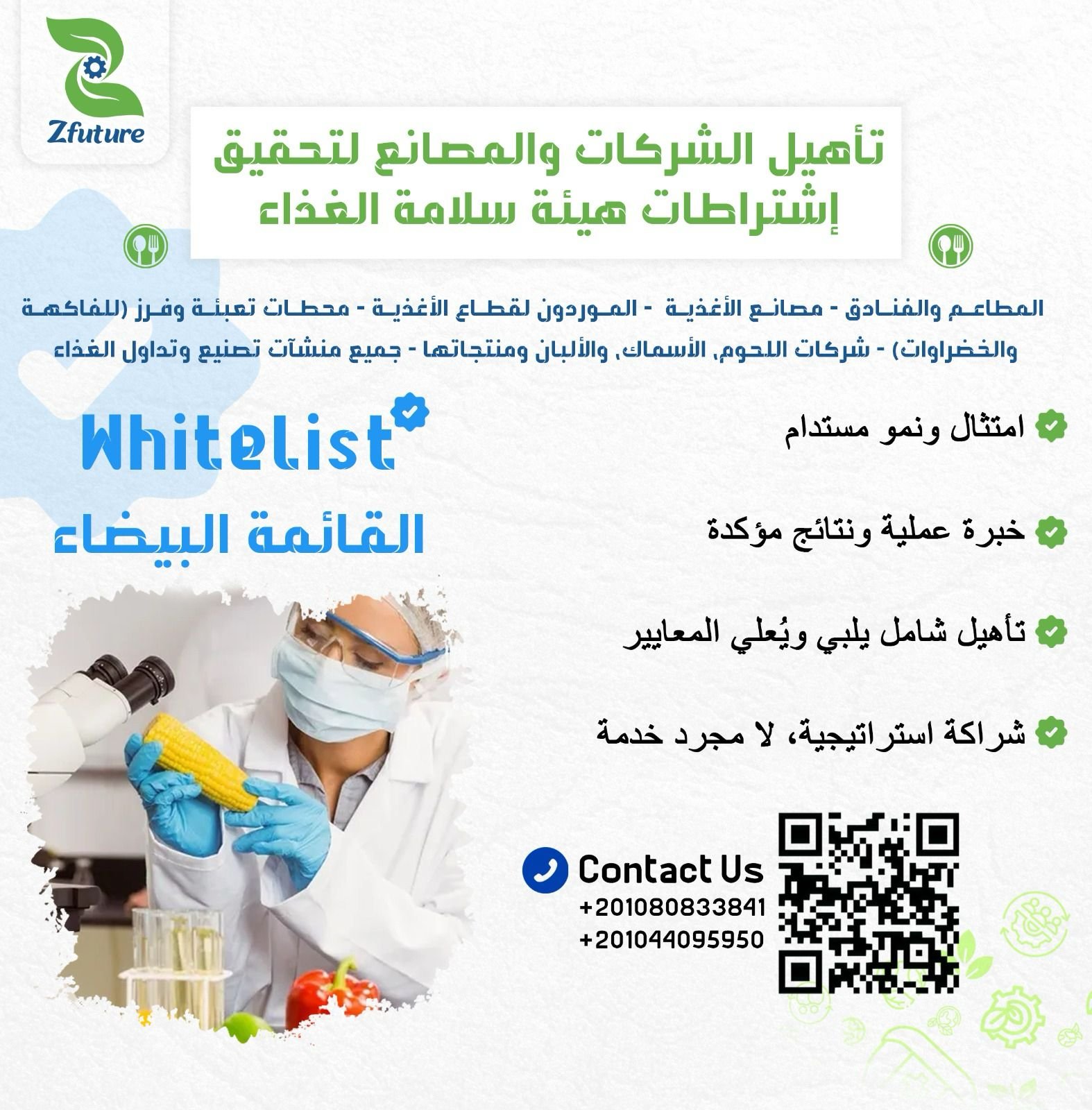Qualifying companies for inclusion on the Food Safety Authority’s White List has become a necessity for every facility operating in the food manufacturing or handling sector in Egypt. With the National Food Safety Authority (NFSA)’s (Egyptian Food Safety Authority) emphasis on compliance with strict food safety standards, obtaining White List certification is a pivotal step toward enhancing credibility and quality.
Contact us Now for free to get all the details from a company Zfuture Consulting and Training
This qualification is based on meeting the requirements of the White List, including full compliance with Good Manufacturing Practices (GMP), implementing the Hazard Analysis and Critical Control Points (HACCP) system, and providing food safety procedures and necessary technical documentation. This is in addition to the importance of equipping food factories in accordance with the requirements of the Food Safety Authority, and ensuring that employees undergo food safety training programs, ensuring the facility is ready to pass technical audits and join the Food Safety Authority White List 2025.

What is the Food Safety Authority White List?
Qualifying companies for inclusion on the Egyptian Food Safety Authority’s White List is an essential step for any food establishment seeking full compliance with the Egyptian Food Safety Authority’s standards and obtaining the accredited White List certification. The White List is an official database containing the names of factories, suppliers, and packaging stations that have met the Food Safety Authority’s requirements. These companies are subject to strict periodic oversight by the Authority to ensure compliance with food safety and manufacturing quality standards.
These requirements include the implementation of a system HACCP Commitment to Good Manufacturing Practices (GMP) and the existence of effective food safety training programs, in addition to preparing food safety documents and providing evidence of product safety through accredited laboratory tests. The establishment’s inclusion on the Food Safety Authority’s white list is an official recognition of the quality of the products and the efficiency of the food system within the establishment, and directly contributes to improving market reputation and increasing export and expansion opportunities.
Therefore, qualifying companies for the Food Safety Authority is not limited to completing the paperwork, but also includes improving infrastructure, raising employee efficiency, and actually complying with global standards, making it a long-term investment in quality and reliability.
Importance Qualifying companies to enter the Food and Safety Authority’s white list
Qualifying companies for inclusion on the Food Safety Authority’s White List is one of the most important strategic steps to ensure compliance with national and international food safety standards. Joining the Food Safety Authority’s White List not only reflects a facility’s commitment to the authority’s requirements, but also opens up broader prospects for it in the local and global markets and enhances consumer and importer confidence in its products.
Companies that undergo the White List qualification process ensure that their facilities undergo rigorous technical reviews, including verification of HACCP implementation, adherence to Good Manufacturing Practices (GMP), provision of food safety records, and employee training in best hygiene and food handling practices. This process also contributes to reducing potential risks of food contamination, improving operational efficiency, and strengthening the organization’s quality and safety management system.
Through food safety consultations and professional food safety documentation, companies can comply with Food Safety Authority requirements, qualifying them for White List certification and giving them a significant competitive advantage in the market, especially in light of the country’s efforts to support reliable, high-quality products.
Food Safety Authority Registration Requirements
To ensure that companies qualify for inclusion on the NFSA White List, food establishments must comply with a set of NFSA requirements, which are the cornerstone for obtaining White List certification and joining the NFSA White List. These requirements include the following:
- Submitting basic legal documents: trade name, proof of ownership, tax card, commercial register extract, company articles of association.
- Provide a detailed explanation of the nature of the facility’s food business and contact information.
- Submit a copy of the registration record in the exporters’ register (for exporting companies).
- Effectively implement the Hazard Analysis and Critical Control Points (HACCP) system and document all its procedures.
- Full compliance with Good Manufacturing Practices (GMP) within manufacturing, storage and food handling units.
- Provide ongoing food safety training programs and document employee training records.
- Ensure an effective temperature monitoring and storage system is in place in accordance with food safety requirements.
- Implement a pest control plan and perform periodic maintenance of the facility.
- Ensuring employees’ personal hygiene and documenting sick leave records.
- Preparing MSDS documents for chemicals and detergents used.
- Qualify suppliers and maintain records of raw material supply from approved sources.
- Establishing an internal food safety and quality management system that complies with international standards such as ISO 22000 and ISO 9001.
- Implementing an awareness and training plan for workers regarding hygiene requirements, disinfection, sterilization, and safe food handling principles.
- Submit an action plan to qualify the facility, including a review of all operations and self-audit in accordance with the Authority’s standards.
- Register online via the Food Safety Authority’s official website or by visiting the Authority’s headquarters.

Documents required to register food establishments
To ensure companies qualify for inclusion on the Food Safety Authority’s white list, food establishments must submit a set of official documents that are a prerequisite for the Food Safety Authority’s requirements. These documents include the following:
- The company’s trade name and proof of ownership.
- Name of the business owner, legal representative or commercial agent.
- Tax registration card.
- A recent extract from the commercial register.
- The articles of association of the company or legal entity of the establishment.
- A detailed explanation of the nature of the company’s food business.
- Official contact information of the facility.
- A copy of the registration record in the exporters’ register (for exporting companies).
Submitting these required documents is the first step toward obtaining White List certification. It enhances the facility’s chances of complying with the requirements of the Egyptian Food Safety Authority and qualifying for membership in the NFSA White List, ensuring official and regulatory recognition at the highest level.
Requirements Qualifying companies to enter the Food and Safety Authority’s white list Individuals and facilities
To ensure that companies qualify for inclusion on the Egyptian Food Safety Authority’s White List, the Egyptian Food Safety Authority imposes a set of requirements related to both the staff and the facilities of the food establishment. Compliance with these requirements reflects the establishment’s compliance with food safety standards and helps it obtain the White List certification. The requirements include the following:
Food Safety Authority requirements for individuals
- Maintain a high level of personal hygiene when handling food.
- Prevent unhealthy behaviors such as smoking, spitting, eating, or coughing near exposed food.
- Wash your hands regularly and wear clean, protective clothing, including special shoes.
- Do not wear personal accessories (watches, jewelry) inside food preparation or handling areas.
- Do not allow sick or suspected infected persons to enter food preparation areas.
- Train employees on food safety according to the nature of their duties, and prepare a monthly or annual training plan.
- Maintain records demonstrating food safety training, effectiveness of training programs, and assessment of training needs.
- Create a sick leave record that shows health conditions among employees.
Food Safety Authority requirements for facilities
- Adherence to Good Manufacturing Practices (GMP) in manufacturing, storage and food handling areas.
- Regular maintenance of buildings and internal structures to ensure the cleanliness and safety of the facility.
- Providing an effective ventilation system that prevents air from moving from polluted to clean areas.
- Provide adequate lighting to detect dirt and contamination, while protecting the lamps to prevent glass from falling into the food.
- Establish adequate restrooms that are completely separate from production areas.
- Having an effective pest control plan and documenting the procedures followed.
- Ensure that the infrastructure supports the implementation of the HACCP system and compliance with Food Safety Authority requirements.

Frequently asked questions about companies qualifying for the Food Safety Authority’s white list.
Food Safety Authority Problems
Despite the significant efforts made by the National Food Safety Authority to qualify companies for inclusion on the Food Safety Authority’s White List, there are a number of challenges and problems facing both the Authority and establishments, which impact the speed and efficiency of registration and compliance processes. The most prominent of these problems are:
- Some companies have limited awareness of the Authority’s requirements, leading to delays in meeting whitelist eligibility requirements or the submission of incomplete documents.
- Lack of adequate training for food facility workers, especially in the areas of HACCP and food safety consulting, which weakens their ability to actually comply.
- Bureaucratic procedures in some branches or sectors, leading to slow processing of applications or approval of companies for whitelist certification.
- The Authority’s inspection teams are limited compared to the number of large, medium, and small food establishments, leading to a backlog of field inspection visits.
- The level of infrastructure varies among establishments applying for registration, as the environment is not always suitable for implementing the Food Safety Authority’s compliance requirements.
- Weak oversight of external suppliers to some factories, which violates one of the most important qualification provisions related to equipping food factories according to Good Manufacturing Practices (GMP).
- Difficulty in accessing some remote or newly industrialized areas that have not been effectively covered by awareness or review campaigns.
Food Safety Non-Conformity Solutions
- Conduct a comprehensive review of facilities and equipment to ensure full compliance with Good Manufacturing Practices.
- Implement an effective HACCP system to identify and control critical control points to reduce potential risks.
- Appoint a dedicated food safety team within the facility to oversee daily compliance and implementation of food safety management procedures.
- Update and document all food safety procedures in accordance with the requirements of the Egyptian Food Safety Authority and upload them to the food safety documentation preparation file.
- Implement an ongoing training program to educate employees within a clear food safety training plan that covers healthy behaviors and food handling.
- Maintain regular inspection and maintenance records that demonstrate periodic follow-up of any observations or violations and respond to them with effective corrective actions.
- Hiring food safety consulting experts to review performance and provide a corrective plan to improve the facility’s position according to NFSA Whitelist standards.
- Ensure supply from approved suppliers registered with the Authority, and maintain an updated list as part of the whitelist qualification requirements.
- Improving the infrastructure within the facility, such as ventilation, lighting, drainage, and separating manufacturing areas from service areas.
- Regularly follow the official website of the Food Safety Authority to learn about any updates to the Food Safety Authority’s requirements.
How do I obtain a Food Safety Authority license?
- Preparing the required official documents (commercial register, tax card, articles of association, proof of ownership).
- Preparing a comprehensive profile of the facility and its production or service activity.
- Implementing HACCP and following Good Manufacturing Practices (GMP) in all operations.
- Provide written food safety procedures and disseminate them within the facility.
- Train staff on hygiene and food safety and maintain training records.
- Appointing a person responsible for implementing the food safety system and forming a quality team.
- Submit a registration application to the Egyptian Food Safety Authority via the official website or visit the headquarters.
- Receiving an inspection committee from the Authority to conduct a field review and assess the extent of compliance.
- Address any comments or corrective actions required according to the audit report.
- Obtain the final license and whitelist certificate after fulfilling the requirements.
How do I get the whitelist?
- Register with the Food Safety Authority through the official website.
- Preparing all required legal documents such as the commercial register, tax card, articles of association, activity license, etc.
- Fully implementing the HACCP system within the facility to ensure food safety at every stage of production and distribution.
- Follow Good Manufacturing Practices (GMP) within the facility to ensure a healthy and safe environment.
- Train employees on hygiene and food safety procedures, and maintain and update training records.
- Registering approved suppliers of raw materials, ensuring their compliance with food safety standards.
- Preparing for a field assessment visit by the Authority’s inspectors to review the facility’s compliance.
- Implement the required corrective actions, if any, based on the inspection report.
- Obtaining a whitelist certificate after ensuring that all requirements and standards are met.

Food safety challenges for factories
Food manufacturers face numerous challenges when qualifying for the Egyptian Food Safety Authority’s white list, particularly when seeking full compliance with the requirements of the Egyptian Food Safety Authority and international standards. The most prominent of these challenges are:
- Poor implementation of the HACCP system to identify and monitor critical control points.
- Failure to fully comply with Good Manufacturing Practices (GMP)
- Lack of food safety training for workers at manufacturing sites.
- Poor documentation of records required by the Egyptian Food Safety Authority.
- Lack of an effective pest control plan within the facility.
- Relying on suppliers not included on the Food Safety Authority’s white list.
- Failure to separate clean and contaminated areas within production lines.
- Weakness in the preparation of infrastructure and facilities in accordance with the requirements of the Food Safety Authority.
- Delay in meeting whitelist requirements due to lack of expertise or capabilities.
- Weak quality management system and non-compliance with standards such as ISO 22000 or HACCP
How to improve the quality of food products
- Effectively implement the HACCP system to monitor and control risks at all stages of production.
- Full commitment to Good Manufacturing Practices (GMP) to ensure a healthy and clean production environment.
- Regularly train employees on food safety and safe handling procedures for raw materials and products.
- Inspect raw materials and ensure they are obtained from approved suppliers on the Food Safety Authority’s white list.
- Improving ventilation, lighting, and drainage systems within facilities to comply with the requirements of the Egyptian Food Safety Authority.
- Implementing strict pest control programs within production and storage units.
- Use accurate, calibrated measuring devices to monitor temperature, humidity, and potential contamination.
- Establish an effective internal control system to review manufacturing, storage, and distribution records.
- Use of safe, food-safe, and standard-compliant packaging materials.
- Develop products based on market feedback, analyze complaints, and continuously improve production lines.
- Ensure full compliance with Food Safety Authority requirements to facilitate obtaining White List certification.
Qualifying food factories for export
- Comply with local food safety authority requirements to obtain a license and official registration for the factory.
- Implementing the HACCP system to ensure hazard analysis and control of critical points at all stages of manufacturing.
- Adherence to Good Manufacturing Practices (GMP) within production lines and warehouses.
- Registration on the Food Safety Authority’s white list to ensure product acceptance in local and global markets.
- Equipping the factory with production facilities that meet international standards in terms of cleanliness, ventilation, lighting, and insulation.
- Ensure all processes are documented and accurate records are maintained related to production, inspection, distribution, and returns.
- Inspect raw materials and suppliers and only deal with approved suppliers to ensure safe inputs.
- Obtain internationally recognized certifications such as ISO 22000 and FSSC 22000 to support export opportunities.
- Working with consultants specialized in qualifying factories for export to develop an integrated quality system.
- Continuously train employees on quality requirements, food safety, and export procedures.
- Compliance with importing country regulations in terms of packaging requirements, coding, language, and necessary analysis.
- Conducting periodic tests on the final product in accredited laboratories to ensure its compliance with export specifications.

How to Avoid Food Safety Violations
- Full compliance with the requirements of the Egyptian Food Safety Authority and updating procedures according to any new amendments.
- Systematically implement the HACCP system to identify and control potential hazards at all stages of production.
- Follow Good Manufacturing Practices (GMP) within manufacturing, storage and packaging units.
- Provide food safety training programs for all employees, including instructions on personal hygiene and food handling.
- Establish an internal control system to monitor compliance with Food Safety Authority requirements and document all operational processes.
- We only deal with certified and whitelisted suppliers to ensure the quality and safety of raw materials.
- Prepare and regularly update all food safety documents, including temperature logs, cleaning, and pest control.
- Conducting periodic tests on final products in laboratories accredited by the Food Safety Authority.
- Check patient records, staff absences, and restrict patient entry to food handling areas.
- Collaborate with food safety consultancies to review performance and ensure full preparedness for field audits.
For more services providedZFUTURE Company :
Certified Carbon Footprint Report
Qualification for ISO 14067 certification
Preparing shops for operating licenses

